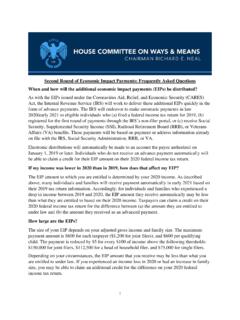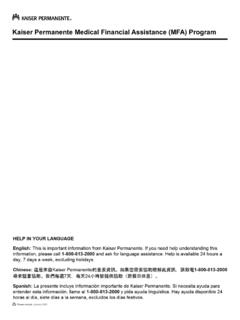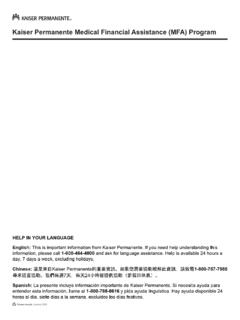Transcription of A Painful Pill to Swallow: U.S. vs. International ...
1 A Painful Pill to Swallow: vs. International Prescription Drug Prices Prepared by Ways and Means Committee Staff September 2019 2 Committee on Ways and Means Table of Contents Appendix A: Methodology ..33 Appendix B: US Rebate Rate Required to Match German Net Appendix C: Country Appendix D: International List Price Comparison Appendix E: International List Price Comparison Disease Appendix F: International List Price Comparison 3 Executive Summary Americans pay on average nearly four times more for drugs than other countries in some cases, 67 times more for the same drug. The United States ( ) spent $457 billion in 2016 on combined retail (dispensed at the pharmacy) and non-retail (dispensed in physician offices) Medicare alone spent nearly $130 billion on prescription drugs that year, $ billion of which was for Part D pharmacy drugs and $ billion of which was for Part B physician-administered In the five years between 2011 and 2016, drug spending nationwide grew by 27 percent more than times the rate of growth in According to a 2018 kaiser family Foundation poll, 79 percent of Americans believe the costs of prescription drugs are unreasonable and 26 percent are worried they cannot afford the prescription drugs they Given the rise in prescription drug costs and the associated out-of-pocket burden on consumers, policymakers and experts are considering models that successfully lower costs.
2 This report examines patterns of drug pricing in the relative to other International comparator countries through a six-part analysis examining price differentials among 79 drugs sold in 11 countries and the in 2017 and 2018. The comparators in our analysis were: the United Kingdom (UK), Japan, Ontario, Australia, Portugal, France, the Netherlands, Germany, Denmark, Sweden, and 1 Observation on Trends in Prescription Drug Spending (2019). Department of Health and Human Services. Retrieved from 2 10 Essential Facts About Medicare and Prescription Drug Spending (2019). Henry J. kaiser family Foundation. Retrieved from 3 Analysis of Centers for Medicare & Medicaid Services, Office of the Actuary prescription drug spending data, Table 11 and BLS data on CPI-U 2011-2016.
3 Retrieved from 4 Public Opinion on Prescription Drugs and Their Prices (2019). Henry J. kaiser family Foundation. Retrieved from 5 Although Ontario is a province and not a country, it is included in the analysis because it purchases its own drugs independently of the rest of Canada. For the purposes of simplicity, we refer to all comparison entities as countries or nations. In all instances throughout this report, this reference to countries is inclusive of Ontario. 4 The pays the most for drugs, though prices varied widely. Across the 79 drugs in our sample, the average list price per dose was $ , ranging from $ to $16, Annual pharmaceutical spending per capita varied from $318 in Denmark to $1,220 in the United States. Average annual per capita spending on pharmaceuticals was $ across the 12 countries, $ excluding the drug prices are on average outliers relative to all comparator countries.
4 Most countries had average drug prices around 24 to 30 percent of those in the United States. The greatest disparity was with Japan, where the average drug price was only 15 percent that of the , meaning that the on average spends seven times what Japan pays for the same drugs. Denmark represented the closest average price, where average drug prices were percent of the average drug price. drug prices were nearly four times higher than average prices compared to similar countries. We found that individual drug prices in the ranged from 708 to 4,833 percent9 higher than the combined mean price in the other 11 countries. On average, drug prices were times higher than the combined average of the other 11 countries in the study. consumers pay significantly more for drugs than in other nations, even when accounting for rebates.
5 One of the major arguments from the pharmaceutical industry justifying these International price differentials is that while list prices are much higher in the , the rebates offered are also significantly higher, so the net price is comparable. To test this claim, we compared rebate rates in the to Germany and found German rebate rates are relatively low compared to rebates, ranging from 0 to 35 percent and averaging percent. rebates would need to average 67 percent to match average German net prices, and the average rebate rate would need to be about percent in order for net prices to match list prices in 6 Premarin in the UK 7 Stelara in the 8 Lantus Solostar 9 Dulera Key Findings: Drug Prices Significantly Higher than All 11 Other Countries The pays the most for drugs, though prices varied widely.
6 Drug prices were nearly four times higher than average prices compared to similar countries. consumers pay significantly more for drugs than other countries, even when accounting for rebates. The could save $49 billion annually on Medicare Part D alone by using average drug prices for comparator countries. 5 the other 11 countries in the study. According to the Congressional Budget Office (CBO) the average rebate rate for band name drugs was 22 percent in The could save $49 billion annually on Medicare Part D alone by using average drug prices for other countries. Using our basket of comparison drugs ( , an index of average drug prices across all 11 countries), we estimated potential Medicare Part D savings if an average of foreign prices were applied to the We replicated this comparison using both German prices and.
7 Drug prices as a benchmark. The spent an estimated $67 billion in 2018 on the 79 drugs in our sample through Medicare Part D plans. Purchasing these same drugs using the basket list price could reduce Part D spending by $ billion annually. The analysis presented in this report clearly illustrates that, across the board, the spends more on drugs than other comparable developed countries. The extent of these pricing differentials varies by drug, manufacturer, and disease group, but the results we present show the existence of large differences between the drug pricing system and other countries and the associated negative effect those differences have on out-of-pocket costs borne by the American consumer and associated costs borne by the taxpayer. The system in place now does not work for the Americans who depend on it by all measures, consumers pay too high a price for drugs.
8 10 Prices for and Spending on Specialty Drugs in Medicare Part D and Medicaid (2019). Congressional Budget Office. Retrieved from 6 Introduction When the Committee on Ways and Means in 1965 marked up proposals to create what would eventually become Title XVIII of the Social Security Act, it dropped the Medicare Part B prescription drug benefit from the bill due to its potentially high and unpredictable For 41 years, Medicare beneficiaries received most of their prescription drugs from other sources employer retirement programs, private Medigap coverage, and Medicaid. The Medicare Modernization Act (MMA) of 2003 changed that by creating Medicare Part D, a voluntary outpatient prescription drug benefit administered through private Since then, Part D has evolved into a plan to protect patients from exorbitant costs, and yet patient burden continues to grow Despite its broad uptake almost 45 million of 59 million Medicare beneficiaries were enrolled in 2019 the benefit has struggled to provide beneficiaries with protections from high out-of-pocket costs in the face of extremely expensive Such consumer-facing inadequacies under Part D have resulted in the Medicare Payment Advisory Commission (MedPAC), presidential budgets (under both Obama and Trump)
9 , and other independent experts to call for changes to the structure of the Part D 16 17 Rapid increases in drug prices have over time exacerbated cracks in the Part D program s benefit Between 2011 and 2016, drug spending nationwide grew by 27 percent more than times the rate of growth in In particular, the rise in spending for specialty drugs has driven the increase in spending in Medicare Part D and A 2019 Congressional Budget Office (CBO) report found that from 2010 to 2015, specialty drugs 11 Oliver, Thomas R. et. al. (2004). A Political History of Medicare and Prescription Drug Coverage. The Milbank Quarterly. Retrieved from #targetText=On%20 December%208%2C%202003%2C%20 President,other%20changes%20to%20the%20p rogram. 12 Id.
10 13 Blum, Jonathan (2006). A History of Creating the Medicare Prescription Drug Benefit. Avalere Health LLC. Retrieved from 14 Cubanski, Juliette and Neuman, Tricia (2019). 10 Things to Know About Medicare Part D Coverage and Costs in 2019. Retrieved from 15 Improving Medicare Part D. Medicare Payment Advisory Commission, June 2016. Retrieved from 16 US Department of Health and Human Services. (2017). Budget in Brief: Strengthening Health and Opportunity for All Americans. Budget in Brief: Strengthening Health and Opportunity for All Americans. Retrieved from 17 US Department of Health and Human Services. (2019). Budget in Brief: Putting America's Health First . Budget in Brief: Putting America's Health First. Retrieved from 18 Id. 19 Analysis of Centers for Medicare & Medicaid Services, Office of the Actuary prescription drug spending data, Table 11 and BLS data on CPI-U 2011-2016.












